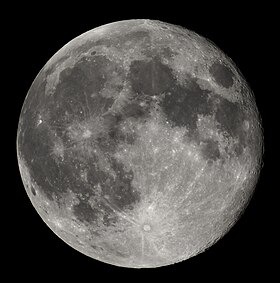 | ||||||||||
Designations | ||||||||||
|---|---|---|---|---|---|---|---|---|---|---|
| Adjective | lunar | |||||||||
| Perigee | 362,570 km (0.0024 AU) (356,400-370,400 km) | |||||||||
| Apogee | 405,410 km (0.0027 AU) (404,000-406,700 km) | |||||||||
| Semi-major axis | 384,399 km (0.00257 AU)[1] | |||||||||
| Eccentricity | 0.0549[1] | |||||||||
| Orbital period | 27.321582 d(27 d 7 h 43.1 min[1]) | |||||||||
| Synodic period | 29.530589 d(29 d 12 h 44 min 2.9 s) | |||||||||
| Average orbital speed | 1.022 km/s | |||||||||
| Inclination | 5.145° to the ecliptic[1] (between 18.29° and 28.58° to Earth's equator) | |||||||||
| Longitude of ascending node | regressing by one revolution in 18.6 years | |||||||||
| Argument of perigee | progressing by one revolution in 8.85 years | |||||||||
| Satellite of | Earth | |||||||||
Physical characteristics | ||||||||||
| Mean radius | 1,737.10 km (0.273 Earths)[1][2] | |||||||||
| Equatorial radius | 1,738.14 km (0.273 Earths)[2] | |||||||||
| Polar radius | 1,735.97 km (0.273 Earths)[2] | |||||||||
| Flattening | 0.00125 | |||||||||
| Circumference | 10,921 km (equatorial) | |||||||||
| Surface area | 3.793 × 107 km2 (0.074 Earths) | |||||||||
| Volume | 2.1958 × 1010 km3 (0.020 Earths) | |||||||||
| Mass | 7.3477 × 1022 kg (0.0123 Earths[1]) | |||||||||
| Mean density | 3.3464 g/cm3[1] | |||||||||
| Equatorial surface gravity | 1.622 m/s2 (0.165 4 g) | |||||||||
| Escape velocity | 2.38 km/s | |||||||||
| Sidereal rotation period | 27.321582 d (synchronous) | |||||||||
| Equatorial rotation velocity | 4.627 m/s | |||||||||
| Axial tilt | 1.5424° (to ecliptic) 6.687° (to orbit plane) | |||||||||
| Albedo | 0.136[3] | |||||||||
| Surface temp. equator 85°N[4] |
| |||||||||
| Apparent magnitude | −2.5 to −12.9[nb 1] −12.74 (mean full Moon)[2] | |||||||||
| Angular diameter | 29.3 to 34.1 arcminutes[2][nb 2] | |||||||||
| Surface pressure | 10−7 Pa (day) 10−10 Pa (night) | |||||||||
| Composition | Ar, He, Na, K, H, Rn | |||||||||
The Moon is Earth's only natural satellite[nb 4][6] and the fifth largest satellite in the Solar System. It is the largest natural satellite of a planet in the Solar System relative to the size of its primary, a quarter the diameter of Earth and 1⁄81 its mass (Charon is proportionally larger in comparison to Pluto, but Pluto has been reclassified as a dwarf planet). The Moon is the second densest satellite after Io. It is in synchronous rotation with Earth, always showing the same face; the near side is marked with dark volcanicmaria among the bright ancient crustal highlands and prominent impact craters. It is the brightest object in the sky after the Sun, although its surface is actually very dark, with a similar reflectance to coal. Its prominence in the sky and its regular cycle of phaseshave since ancient times made the Moon an important cultural influence on language, calendars, art and mythology. The Moon's gravitational influence produces the ocean tides and the minute lengthening of the day. The Moon's current orbital distance, about thirty times the diameter of the Earth, causes it to appear almost the same size in the sky as the Sun, allowing it to cover the Sun nearly precisely in total solar eclipses.
The Moon is the only celestial body on which humans have landed. While the Soviet Union's Luna programme was the first to reach the Moon with unmanned spacecraft in 1959, the United States' NASA Apollo program achieved the only manned missions to date, beginning with the first manned lunar orbiting mission by Apollo 8 in 1968, and six manned lunar landings between 1969 and 1972—the first being Apollo 11. These missions returned over 380 kg of lunar rocks, which have been used to develop a detailed geological understanding of the Moon's origins (it is thought to have formed some 4.5 billion years ago in a giant impact event involving Earth), the formation of its internal structure, and its subsequent history.
After the Apollo 17 mission in 1972, the Moon has been visited only by unmanned spacecraft, notably by the final Soviet Lunokhodrover. Since 2004, Japan, China, India, the United States, and the European Space Agency have each sent lunar orbiters. These spacecraft have contributed to confirming the discovery of lunar water ice in permanently shadowed craters at the poles and bound into the lunar regolith. Future manned missions to the Moon have been planned, including government as well as privately funded efforts. The Moon remains, under the Outer Space Treaty, free to all nations to explore for peaceful purposes.
Contents[hide] |
Name and etymology
The English proper name for Earth's natural satellite is "the Moon".[7][8] The noun moon derives from moone (around 1380), which developed from mone (1135), which derives from Old English mōna (dating from before 725), which, like all Germanic languagecognates, ultimately stems from Proto-Germanic *mǣnōn.[9]
The principal modern English adjective pertaining to the Moon is lunar, derived from the Latin Luna. Another less common adjective isselenic, derived from the Ancient Greek Selene (Σελήνη), from which the prefix "seleno-" (as in selenography) is derived.[10]
Formation
Several mechanisms have been proposed for the Moon's formation 4.527 ± 0.010 billion years ago,[nb 5] some 30–50 million years after the origin of the Solar System.[11] These include the fission of the Moon from the Earth's crust through centrifugal forces,[12]which would require too great an initial spin of the Earth,[13] the gravitational capture of a pre-formed Moon,[14] which would require an unfeasibly extended atmosphere of the Earth to dissipate the energy of the passing Moon,[13] and the co-formation of the Earth and the Moon together in the primordial accretion disk, which does not explain the depletion of metallic iron in the Moon.[13] These hypotheses also cannot account for the high angular momentum of the Earth–Moon system.[15]
The prevailing hypothesis today is that the Earth–Moon system formed as a result of a giant impact: a Mars-sized body hit the nearly formed proto-Earth, blasting material into orbit around the proto-Earth, which accreted to form the Moon.[16] Giant impacts are thought to have been common in the early Solar System. Computer simulations modelling a giant impact are consistent with measurements of the angular momentum of the Earth–Moon system, and the small size of the lunar core; they also show that most of the Moon came from the impactor, not from the proto-Earth.[17] However, meteorites show that other inner Solar System bodies such as Mars and Vesta have very different oxygen and tungsten isotopiccompositions to the Earth, while the Earth and Moon have near-identical isotopic compositions. Post-impact mixing of the vaporized material between the forming Earth and Moon could have equalized their isotopic compositions,[18] although this is debated.[19]
The large amount of energy released in the giant impact event and the subsequent reaccretion of material in Earth orbit would have melted the outer shell of the Earth, forming a magma ocean.[20][21] The newly formed Moon would also have had its own lunar magma ocean; estimates for its depth range from about 500 km to the entire radius of the Moon.[20]
Physical characteristics
Internal structure
| Compound | Formula | Composition (wt %) | |
|---|---|---|---|
| Maria | Highlands | ||
| silica | SiO2 | 45.4% | 45.5% |
| alumina | Al2O3 | 14.9% | 24.0% |
| lime | CaO | 11.8% | 15.9% |
| iron(II) oxide | FeO | 14.1% | 5.9% |
| magnesia | MgO | 9.2% | 7.5% |
| titanium dioxide | TiO2 | 3.9% | 0.6% |
| sodium oxide | Na2O | 0.6% | 0.6% |
| Total | 99.9% | 100.0% | |
The Moon is a differentiated body: it has a geochemically distinct crust, mantle, and core. The moon has a solid iron-rich inner core with a radius of 240 kilometers and a fluid outer core primarily made of liquid iron with a radius of roughly 300 kilometers. Around the core is a partially molten boundary layer with a radius of about 500 kilometers.[23] This structure is thought to have developed through the fractional crystallization of a global magma ocean shortly after the Moon's formation 4.5 billion years ago.[24] Crystallization of this magma ocean would have created a maficmantle from the precipitation and sinking of the minerals olivine, clinopyroxene, and orthopyroxene; after about three-quarters of the magma ocean had crystallised, lower-density plagioclase minerals could form and float into a crust on top.[25] The final liquids to crystallise would have been initially sandwiched between the crust and mantle, with a high abundance of incompatible and heat-producing elements.[1] Consistent with this, geochemical mapping from orbit shows the crust is mostly anorthosite,[5] and moon rock samples of the flood lavas erupted on the surface from partial melting in the mantle confirm the mafic mantle composition, which is more iron rich than that of Earth.[1] Geophysical techniques suggest that the crust is on average ~50 km thick.[1]
The Moon is the second densest satellite in the Solar System after Io.[26] However, the inner core of the Moon is small, with a radius of about 350 km or less;[1] this is only ~20% the size of the Moon, in contrast to the ~50% of most other terrestrial bodies. Its composition is not well constrained, but it is probably metallic iron alloyed with a small amount of sulphur and nickel; analyses of the Moon's time-variable rotation indicate that it is at least partly molten.[27]
Surface geology
The topography of the Moon has been measured with laser altimetry and stereo image analysis.[29] The most visible topographic feature is the giant far side South Pole – Aitken basin, some 2,240 km in diameter, the largest crater on the Moon and the largest known crater in the Solar System.[30][31] At 13 km deep, its floor is the lowest elevation on the Moon.[30][32] The highest elevations are found just to its north-east, and it has been suggested that this area might have been thickened by the oblique formation impact of South Pole – Aitken.[33] Other large impact basins, such as Imbrium, Serenitatis, Crisium, Smythii, and Orientale, also possess regionally low elevations and elevated rims.[30] The lunar far side is on average about 1.9 km higher than the near side.[1]
Volcanic features
The dark and relatively featureless lunar plains which can clearly be seen with the naked eye are called maria (Latin for "seas"; singular mare), since they were believed by ancient astronomers to be filled with water.[34] They are now known to be vast solidified pools of ancient basaltic lava. While similar to terrestrial basalts, the mare basalts have much higher abundances of iron and are completely lacking in minerals altered by water.[35][36] The majority of these lavas erupted or flowed into the depressions associated with impact basins. Several geologic provinces containing shield volcanoes and volcanic domes are found within the near side maria.[37]
Maria are found almost exclusively on the near side of the Moon, covering 31% of the surface on the near side,[38]compared with a few scattered patches on the far side covering only 2%.[39] This is thought to be due to a concentration of heat-producing elements under the crust on the near side, seen on geochemical maps obtained by Lunar Prospector's gamma-ray spectrometer, which would have caused the underlying mantle to heat up, partially melt, rise to the surface and erupt.[25][40][41] Most of the Moon's mare basalts erupted during the Imbrian period, 3.0–3.5 billion years ago, although some radiometrically dated samples are as old as 4.2 billion years,[42] and the youngest eruptions, dated bycrater counting, appear to have been only 1.2 billion years ago.[43]
The lighter-coloured regions of the Moon are called terrae, or more commonly highlands, since they are higher than most maria. They have been radiometrically dated as forming 4.4 billion years ago, and may represent plagioclase cumulatesof the lunar magma ocean.[42][43] In contrast to the Earth, no major lunar mountains are believed to have formed as a result of tectonic events.[44]
Impact craters
The other major geologic process that has affected the Moon's surface is impact cratering,[45] with craters formed when asteroids and comets collide with the lunar surface. There are estimated to be roughly 300,000 craters wider than 1 km on the Moon's near side alone.[46] Some of these are named for scholars, scientists, artists and explorers.[47] The lunar geologic timescale is based on the most prominent impact events, including Nectaris, Imbrium, and Orientale, structures characterized by multiple rings of uplifted material, typically hundreds to thousands of kilometres in diameter and associated with a broad apron of ejecta deposits that form a regional stratigraphic horizon.[48] The lack of an atmosphere, weather and recent geological processes mean that many of these craters are well-preserved. While only a few multi-ring basins have been definitively dated, they are useful for assigning relative ages. Since impact craters accumulate at a nearly constant rate, counting the number of craters per unit area can be used to estimate the age of the surface.[48] The radiometric ages of impact-melted rocks collected during theApollo missions cluster between 3.8 and 4.1 billion years old: this has been used to propose a Late Heavy Bombardment of impacts.[49]
Blanketed on top of the Moon's crust is a highly comminuted (broken into ever smaller particles) and impact gardened surface layer called regolith, formed by impact processes. The finer regolith, the lunar soil of silicon dioxide glass, has a texture like snow and smell like spent gunpowder.[50] The regolith of older surfaces is generally thicker than for younger surfaces: it varies in thickness from 10–20 m in the highlands and 3–5 m in the maria.[51] Beneath the finely comminuted regolith layer is the megaregolith, a layer of highly fractured bedrock many kilometres thick.[52]
Presence of water
Liquid water cannot persist on the lunar surface. When exposed to solar radiation, water quickly decomposes through a process known asphotodissociation and is lost to space. However since the 1960s, scientists have hypothesized that water ice may be deposited by impactingcomets or possibly produced by the reaction of oxygen-rich lunar rocks, and hydrogen from solar wind, leaving traces of water which could possibly survive in cold, permanently shadowed craters at either pole on the Moon.[53][54] Computer simulations suggest that up to 14,000 km2of the surface may be in permanent shadow.[55] The presence of usable quantities of water on the Moon is an important factor in renderinglunar habitation as a cost-effective plan; the alternative of transporting water from Earth would be prohibitively expensive.[56]
In years since, signatures of water have been found to exist on the lunar surface.[57] In 1994, the bistatic radar experiment located on theClementine spacecraft, indicated the existence of small, frozen pockets of water close to the surface. However, later radar observations byArecibo, suggest these findings may rather be rocks ejected from young impact craters.[58] In 1998, the neutron spectrometer located on theLunar Prospector spacecraft, indicated that high concentrations of hydrogen are present in the first meter of depth in the regolith near the polar regions.[59] In 2008, an analysis of volcanic lava beads, brought back to Earth aboard Apollo 15, showed small amounts of water to exist in the interior of the beads.[60]
The 2008, Chandrayaan-1 spacecraft has since confirmed the existence of surface water ice, using the on-board Moon Mineralogy Mapper. The spectrometer observed absorption lines common to hydroxyl, in reflected sunlight, providing evidence of large quantities of water ice, on the lunar surface. The spacecraft showed that concentrations may possibly be as high as 1,000 ppm.[61] In 2009, LCROSS sent a 2300 kg impactor into a permanently shadowed polar crater, and detected at least 100 kg of water in a plume of ejected material.[62][63] Another examination of the LCROSS data showed the amount of detected water, to be closer to 155-kilograms (± 12 kg).[64]
In May 2011, Erik Hauri et al. reported[65] 615-1410 ppm water in melt inclusions in lunar sample 74220, the famous high-titanium "orange glass soil" of volcanic origin collected during the Apollo 17 mission in 1972. The inclusions were formed during explosive eruptions on the moon approximately 3.7 billion years ago.
This concentration is comparable with that of magma in Earth's upper mantle. While of considerable selenological interest, this announcement affords little comfort to would-be lunar colonists. The sample originated many kilometers below the surface, and the inclusions are so difficult to access that it took 39 years to find them with a state-of-the-art ion microprobe instrument.
Gravity and magnetic fields
The gravitational field of the Moon has been measured through tracking the Doppler shift of radio signals emitted by orbiting spacecraft. The main lunar gravity features are mascons, large positive gravitational anomalies associated with some of the giant impact basins, partly caused by the dense mare basaltic lava flows that fill these basins.[66] These anomalies greatly influence the orbit of spacecraft about the Moon. There are some puzzles: lava flows by themselves cannot explain all of the gravitational signature, and some mascons exist that are not linked to mare volcanism.[67]
The Moon has an external magnetic field of the order of one to a hundred nanoteslas, less than one-hundredth that of the Earth. It does not currently have a global dipolar magnetic field, as would be generated by a liquid metal core geodynamo, and only has crustal magnetization, probably acquired early in lunar history when a geodynamo was still operating.[68][69]Alternatively, some of the remnant magnetization may be from transient magnetic fields generated during large impact events, through the expansion of an impact-generated plasma cloud in the presence of an ambient magnetic field—this is supported by the apparent location of the largest crustal magnetizations near the antipodes of the giant impact basins.[70]
Atmosphere
The Moon has an atmosphere so tenuous as to be nearly vacuum, with a total mass of less than 10 metric tons.[71] The surface pressure of this small mass is around 3 × 10−15 atm(0.3 nPa); it varies with the lunar day. Its sources include outgassing and sputtering, the release of atoms from the bombardment of lunar soil by solar wind ions.[5][72] Elements that have been detected include sodium and potassium, produced by sputtering, which are also found in the atmospheres of Mercury and Io; helium-4 from the solar wind; and argon-40, radon-222, and polonium-210, outgassed after their creation by radioactive decay within the crust and mantle.[73][74] The absence of such neutral species (atoms or molecules) as oxygen, nitrogen,carbon, hydrogen and magnesium, which are present in the regolith, is not understood.[73] Water vapour has been detected by Chandrayaan-1 and found to vary with latitude, with a maximum at ~60–70 degrees; it is possibly generated from the sublimation of water ice in the regolith.[75] These gases can either return into the regolith due to the Moon's gravity, or be lost to space: either through solar radiation pressure, or if they are ionised, by being swept away by the solar wind's magnetic field.[73]
Seasons
The Moon's axial tilt is only 1.54°, much less than the 23.44° of the Earth. Because of this, the Moon's solar illumination varies much less with season, and topographical details play a crucial role in seasonal effects.[76] From images taken by Clementine in 1994, it appears that four mountainous regions on the rim of Peary crater at the Moon's north pole remain illuminated for the entire lunar day, creating peaks of eternal light. No such regions exist at the south pole. Similarly, there are places that remain in permanent shadow at the bottoms of many polar craters,[55] and these dark craters are extremely cold: Lunar Reconnaissance Orbiter measured the lowest summer temperatures in craters at the southern pole at 35 K (−238 °C),[77] and just 26 K close to the winter solstice in north polar Hermite Crater. This is the coldest temperature in the Solar System ever measured by a spacecraft, colder even than the surface of Pluto.[76]
Relationship to Earth
Orbit
The Moon makes a complete orbit around the Earth with respect to the fixed stars about once every 27.3 days[nb 6] (itssidereal period). However, since the Earth is moving in its orbit about the Sun at the same time, it takes slightly longer for the Moon to show the same phase to Earth, which is about 29.5 days[nb 7] (its synodic period).[38] Unlike most satellites of other planets, the Moon orbits nearer the ecliptic plane than to the planet's equatorial plane. The Moon's orbit is subtly perturbed by the Sun and Earth in many small, complex and interacting ways. For example, the plane of the Moon's orbital motion gradually rotates, which affects other aspects of lunar motion. These follow-on effects are mathematically described by Cassini's laws.[78]
Relative size
The Moon is exceptionally large relative to the Earth: a quarter the diameter of the planet and 1/81 its mass.[38] It is the largest moon orbiting a planet in the solar system relative to the size of its planet (although Charon is larger relative to the dwarf planetPluto, at slightly more than 1/9 (11.6%) of Pluto's mass.)[80]
However, the Earth and Moon are still considered a planet–satellite system, rather than a double-planet system, as their barycentre, the common centre of mass, is located 1,700 km (about a quarter of the Earth's radius) beneath the surface of the Earth.[81]
Appearance from Earth
The Moon is in synchronous rotation: it rotates about its axis in about the same time it takes to orbit the Earth. This results in it nearly always keeping the same face turned towards the Earth. The Moon used to rotate at a faster rate, but early in its history, its rotation slowed and became tidally locked in this orientation as a result of frictional effects associated with tidal deformations caused by the Earth.[82] The side of the Moon that faces Earth is called the near side, and the opposite side the far side. The far side is often called the "dark side," but in fact, it is illuminated as often as the near side: once per lunar day, during the new Moon phase we observe on Earth when the near side is dark.[83]
The Moon has an exceptionally low albedo, giving it a similar reflectance to coal. Despite this, it is the second brightest object in the sky after the Sun.[38][nb 8] This is partly due to the brightness enhancement of the opposition effect; at quarter phase, the Moon is only one-tenth as bright, rather than half as bright, as at full Moon.[84] Additionally, colour constancy in thevisual system recalibrates the relations between the colours of an object and its surroundings, and since the surrounding sky is comparatively dark, the sunlit Moon is perceived as a bright object. The edges of the full Moon seem as bright as the centre, with no limb darkening, due to the reflective properties of lunar soil, which reflects more light back towards the Sun than in other directions. The Moon does appear larger when close to the horizon, but this is a purely psychological effect, known as the Moon illusion, first described in the 7th century BC.[85] The full Moon subtends an arc of about 0.52° (on average) in the sky, roughly the same apparent size as the Sun (see eclipses).
The highest altitude of the Moon in the sky varies: while it has nearly the same limit as the Sun, it alters with the lunar phase and with the season of the year, with the full Moon highest during winter. The 18.6-year nodes cycle also has an influence: when the ascending node of the lunar orbit is in the vernal equinox, the lunar declination can go as far as 28° each month. This means the Moon can go overhead at latitudes up to 28° from the equator, instead of only 18°. The orientation of the Moon's crescent also depends on the latitude of the observation site: close to the equator, an observer can see a smile-shaped crescent Moon.[86]
The distance between the moon and the Earth varies from around 356,400 km to 406,700 km at the extreme perigees (closest) and apogees (farthest). On 19 March 2011, it was closer to the earth while at full phase than it has been since 1993.[87] Reported as a "super moon", this closest point coincides within an hour of a full moon, and it thus appeared 30 percent brighter, and 14 percent larger than when at its greatest distance.[88][89][90]
There has been historical controversy over whether features on the Moon's surface change over time. Today, many of these claims are thought to be illusory, resulting from observation under different lighting conditions, poor astronomical seeing, or inadequate drawings. However, outgassing does occasionally occur, and could be responsible for a minor percentage of the reported lunar transient phenomena. Recently, it has been suggested that a roughly 3 km diameter region of the lunar surface was modified by a gas release event about a million years ago.[91][92] The Moon's appearance, like that of the Sun, can be affected by Earth's atmosphere: common effects are a 22° halo ring formed when the Moon's light is refracted through the ice crystals of high cirrostratus cloud, and smaller coronal rings when the Moon is seen through thin clouds.[93]
Tidal effects
The tides on the Earth are mostly generated by the gradient in intensity of the Moon's gravitational pull from one side of the Earth to the other, the tidal forces. This forms two tidal bulges on the Earth, which are most clearly seen in elevated sea level as ocean tides.[94] Since the Earth spins about 27 times faster than the Moon moves around it, the bulges are dragged along with the Earth's surface faster than the Moon moves, rotating around the Earth once a day as it spins on its axis.[94] The ocean tides are magnified by other effects: frictional coupling of water to Earth's rotation through the ocean floors, the inertia of water's movement, ocean basins that get shallower near land, and oscillations between different ocean basins.[95] The gravitational attraction of the Sun on the Earth's oceans is almost half that of the Moon, and their gravitational interplay is responsible for spring and neap tides.[94]
Gravitational coupling between the Moon and the bulge nearest the Moon acts as a torque on the Earth's rotation, draining angular momentumand rotational kinetic energy from the Earth's spin.[94][96] In turn, angular momentum is added to the Moon's orbit, accelerating it, which lifts the Moon into a higher orbit with a longer period. As a result, the distance between the Earth and Moon is increasing, and the Earth's spin slowing down.[96] Measurements from lunar ranging experiments with laser reflectors left during the Apollo missions have found that the Moon's distance to the Earth increases by 38 mm per year[97] (though this is only 0.10 ppb/year of the radius of the Moon's orbit). Atomic clocks also show that the Earth's day lengthens by about 15 microseconds every year,[98] slowly increasing the rate at which UTC is adjusted by leap seconds. This tidal drag will continue until the spin of the Earth has slowed to match the orbital period of the Moon; however, long before this could happen, the Sun will have become a red giant, engulfing the Earth.[99][100]
The lunar surface also experiences tides of amplitude ~10 cm over 27 days, with two components: a fixed one due to the Earth, as they are insynchronous rotation, and a varying component from the Sun.[96] The Earth-induced component arises from libration, a result of the Moon's orbital eccentricity; if the Moon's orbit were perfectly circular, there would only be solar tides.[96] Libration also changes the angle from which the Moon is seen, allowing about 59% of its surface to be seen from the Earth (but only half at any instant).[38] The cumulative effects of stress built up by these tidal forces produces moonquakes. Moonquakes are much less common and weaker than earthquakes, although they can last for up to an hour – a significantly longer time than terrestrial earthquakes – because of the absence of water to damp out the seismic vibrations. The existence of moonquakes was an unexpected discovery from seismometers placed on the Moon by Apollo astronauts from 1969 through 1972.[101]
Eclipses
Eclipses can only occur when the Sun, Earth, and Moon are all in a straight line (termed "syzygy"). Solar eclipses occur near anew Moon, when the Moon is between the Sun and Earth. In contrast, lunar eclipses occur near a full Moon, when the Earth is between the Sun and Moon. The apparent size of the Moon is roughly the same as that of the Sun, with both being viewed at close to one-half a degree wide. The Sun is much larger than the Moon but it is the precise vastly greater distance that coincidentally gives it the same apparent size as the much closer and much smaller Moon from the perspective of the Earth. The variations in apparent size, due to the non-circular orbits, are nearly the same as well, though occurring in different cycles. This makes possible both total (with the Moon appearing larger than the Sun) and annular (with the Moon appearing smaller than the Sun) solar eclipses.[103] In a total eclipse, the Moon completely covers the disc of the Sun and the solar coronabecomes visible to the naked eye. Since the distance between the Moon and the Earth is very slowly increasing over time,[94]the angular diameter of the Moon is decreasing. This means that hundreds of millions of years ago the Moon would always completely cover the Sun on solar eclipses, and no annular eclipses were possible. Likewise, about 600 million years from now (if the angular diameter of the Sun does not change), the Moon will no longer cover the Sun completely, and only annular eclipses will occur.[104]
Because the Moon's orbit around the Earth is inclined by about 5° to the orbit of the Earth around the Sun, eclipses do not occur at every full and new Moon. For an eclipse to occur, the Moon must be near the intersection of the two orbital planes.[104]The periodicity and recurrence of eclipses of the Sun by the Moon, and of the Moon by the Earth, is described by the saros cycle, which has a period of approximately 18 years.[105]
As the Moon is continuously blocking our view of a half-degree-wide circular area of the sky,[nb 9][106] the related phenomenon of occultation occurs when a bright star or planet passes behind the Moon and is occulted: hidden from view. In this way, a solar eclipse is an occultation of the Sun. Because the Moon is comparatively close to the Earth, occultations of individual stars are not visible everywhere on the planet, nor at the same time. Because of the precession of the lunar orbit, each year different stars are occulted.[107]
Study and exploration
Early studies
Understanding of the Moon's cycles was an early development of astronomy: by the 5th century BC, Babylonian astronomers had recorded the 18-year Saros cycle of lunar eclipses,[108] and Indian astronomers had described the Moon’s monthly elongation.[109] The Chinese astronomerShi Shen (fl. 4th century BC) gave instructions for predicting solar and lunar eclipses.[110] Later, the physical form of the Moon and the cause of moonlight became understood. The ancient Greek philosopher Anaxagoras (d. 428 BC) reasoned that the Sun and Moon were both giant spherical rocks, and that the latter reflected the light of the former.[111][112] Although the Chinese of the Han Dynasty believed the Moon to be energy equated to qi, their 'radiating influence' theory also recognized that the light of the Moon was merely a reflection of the Sun, and Jing Fang (78–37 BC) noted the sphericity of the Moon.[113] In 499 AD, the Indian astronomer Aryabhata mentioned in his Aryabhatiya that reflected sunlight is the cause of the shining of the Moon.[114] The astronomer and physicist Alhazen (965–1039) found that sunlight was not reflected from the Moon like a mirror, but that light was emitted from every part of the Moon's sunlit surface in all directions.[115] Shen Kuo (1031–1095) of the Song Dynasty created an allegory equating the waxing and waning of the Moon to a round ball of reflective silver that, when doused with white powder and viewed from the side, would appear to be a crescent.[116]
In Aristotle's (384–322 BC) description of the universe, the Moon marked the boundary between the spheres of the mutable elements (earth, water, air and fire), and the imperishable stars of aether, an influential philosophy that would dominate for centuries.[117] However, in the 2nd century BC, Seleucus of Seleucia correctly theorized that tides were due to the attraction of the Moon, and that their height depends on the Moon's position relative to the Sun.[118] In the same century, Aristarchus computed the size and distance of the Moon from Earth, obtaining a value of about twenty times the Earth radius for the distance. These figures were greatly improved by Ptolemy (90–168 AD): his values of a mean distance of 59 times the Earth's radius and a diameter of 0.292 Earth diameters were close to the correct values of about 60 and 0.273 respectively.[119] Archimedes(287–212 BC) invented a planetarium calculating motions of the Moon and the known planets.[120]
During the Middle Ages, before the invention of the telescope, the Moon was increasingly recognised as a sphere, though many believed that it was "perfectly smooth".[121] In 1609,Galileo Galilei drew one of the first telescopic drawings of the Moon in his book Sidereus Nuncius and noted that it was not smooth but had mountains and craters. Telescopic mapping of the Moon followed: later in the 17th century, the efforts of Giovanni Battista Riccioli and Francesco Maria Grimaldi led to the system of naming of lunar features in use today. The more exact 1834-6 Mappa Selenographica of Wilhelm Beer and Johann Heinrich Mädler, and their associated 1837 book Der Mond, the first trigonometrically accurate study of lunar features, included the heights of more than a thousand mountains, and introduced the study of the Moon at accuracies possible in earthly geography.[122] Lunar craters, first noted by Galileo, were thought to be volcanic until the 1870s proposal of Richard Proctor that they were formed by collisions.[38] This view gained support in 1892 from the experimentation of geologistGrove Karl Gilbert, and from comparative studies from 1920 to the 1940s,[123] leading to the development of lunar stratigraphy, which by the 1950s was becoming a new and growing branch of astrogeology.[38]
First direct exploration: 1959–1976
Soviet missions
The Cold War-inspired Space Race between the Soviet Union and the U.S. led to an acceleration of interest in exploration of the Moon. Once launchers had the necessary capabilities, these nations sent unmanned probes on both flyby and impact/lander missions. Spacecraft from the Soviet Union's Luna program were the first to accomplish a number of goals: following three unnamed, failed missions in 1958,[124] the first man-made object to escape Earth's gravity and pass near the Moon was Luna 1; the first man-made object to impact the lunar surface wasLuna 2, and the first photographs of the normally occluded far side of the Moon were made by Luna 3, all in 1959.
The first spacecraft to perform a successful lunar soft landing was Luna 9 and the first unmanned vehicle to orbit the Moon was Luna 10, both in 1966.[38] Rock and soil samples were brought back to Earth by three Luna sample return missions (Luna 16, 20, and 24), which returned 0.3 kg total.[125] Two pioneering robotic rovers landed on the Moon in 1970 and 1973 as a part of Soviet Lunokhod programme.
United States missions
American lunar exploration began with robotic missions aimed at developing understanding of the lunar surface for an eventual manned landing: the Jet Propulsion Laboratory's Surveyor program landed its first spacecraft four months after Luna 9. NASA's manned Apollo program was developed in parallel; after a series of unmanned and manned tests of the Apollo spacecraft in Earth orbit, and spurred on by a potential Soviet lunar flight, in 1968 Apollo 8 made the first crewed mission to lunar orbit. The subsequent landing of the first humans on the Moon in 1969 is seen by many as the culmination of the Space Race.[126] Neil Armstrong became the first person to walk on the Moon as the commander of the American mission Apollo 11 by first setting foot on the Moon at 02:56 UTC on 21 July 1969.[127] The Apollo missions 11 to 17 (exceptApollo 13, which aborted its planned lunar landing) returned 382 kg of lunar rock and soil in 2,196 separate samples.[128] The American Moon landing and return was enabled by considerable technological advances in the early 1960s, in domains such as ablation chemistry, software engineering and atmospheric re-entry technology, and by highly competent management of the enormous technical undertaking.[129][130]
Scientific instrument packages were installed on the lunar surface during all the Apollo missions. Long-lived instrument stations, including heat flow probes, seismometers, and magnetometers, were installed at the Apollo 12, 14, 15, 16, and 17 landing sites. Direct transmission of data to Earth concluded in late 1977 due to budgetary considerations,[131][132] but as the stations' lunar laser ranging corner-cube retroreflector arrays are passive instruments, they are still being used. Ranging to the stations is routinely performed from earth-based stations with an accuracy of a few centimetres, and data from this experiment are being used to place constraints on the size of the lunar core.[133]
Current era: 1990–present
Post-Apollo and Luna, many more countries have become involved in direct exploration of the Moon. In 1990, Japan became the third country to place a spacecraft into lunar orbit with its Hiten spacecraft. The spacecraft released a smaller probe, Hagoromo, in lunar orbit, but the transmitter failed, preventing further scientific use of the mission.[134] In 1994, the U.S. sent the joint Defense Department/NASA spacecraftClementine to lunar orbit. This mission obtained the first near-global topographic map of the Moon, and the first global multispectral images of the lunar surface.[135] This was followed in 1998 by the Lunar Prospector mission, whose instruments indicated the presence of excess hydrogen at the lunar poles, which is likely to have been caused by the presence of water ice in the upper few meters of the regolith within permanently shadowed craters.[136]
The European spacecraft SMART-1, the second ion-propelled spacecraft, was in lunar orbit from 15 November 2004 until its lunar impact on 3 September 2006, and made the first detailed survey of chemical elements on the lunar surface.[137] China has expressed ambitious plans for exploring the Moon, and successfully orbited its first spacecraft, Chang'e-1, from 5 November 2007 until its controlled lunar impact on 1 March 2008.[138] In its sixteen-month mission, it obtained a full image map of the Moon. Between 4 October 2007 and 10 June 2009, the Japan Aerospace Exploration Agency's Kaguya (Selene) mission, a lunar orbiter fitted with a high-definition video camera, and two small radio-transmitter satellites, obtained lunar geophysics data and took the first high-definition movies from beyond Earth orbit.[139][140] India's first lunar mission, Chandrayaan I, orbited from 8 November 2008 until loss of contact on 27 August 2009, creating a high resolution chemical, mineralogical and photo-geological map of the lunar surface, and confirming the presence of water molecules in lunar soil.[141] The Indian Space Research Organisation plans to launch Chandrayaan II in 2013, which is slated to include a Russian robotic lunar rover.[142][143] The U.S. co-launched the Lunar Reconnaissance Orbiter (LRO) and the LCROSS impactor and follow-up observation orbiter on 18 June 2009;LCROSS completed its mission by making a planned and widely observed impact in the crater Cabeus on 9 October 2009,[144] while LRO is currently in operation, obtaining precise lunar altimetry and high-resolution imagery.
Other upcoming lunar missions include Russia's Luna-Glob: an unmanned lander, set of seismometers, and an orbiter based on its Martian Phobos-Grunt mission, which is slated to launch in 2012.[145][146] Privately funded lunar exploration has been promoted by the Google Lunar X Prize, announced 13 September 2007, which offers US$20 million to anyone who can land a robotic rover on the Moon and meet other specified criteria.[147]
NASA began to plan to resume manned missions following the call by U.S. President George W. Bush on 14 January 2004 for a manned mission to the Moon by 2019 and the construction of a lunar base by 2024.[148] The Constellation program was funded and construction and testing begun on a manned spacecraft and launch vehicle,[149] and design studies for a lunar base.[150] However, that program has been cancelled in favour of a manned asteroid landing by 2025 and a manned Mars orbit by 2035.[151] India has also expressed its hope to send a manned mission to the Moon by 2020.[152]
Astronomy from the Moon
For many years, the Moon has been recognized as an excellent site for telescopes.[153] It is relatively nearby; astronomical seeing is not a concern; certain craters near the poles are permanently dark and cold, and thus especially useful for infrared telescopes; and radio telescopes on the far side would be shielded from the radio chatter of Earth.[154] The lunar soil, although it poses a problem for any moving parts of telescopes, can be mixed with carbon nanotubes and epoxies in the construction of mirrors up to 50 meters in diameter.[155] A lunarzenith telescope can be made cheaply with ionic liquid.[156]
Legal status
Although Luna landers scattered pennants of the Soviet Union on the Moon, and U.S. flags were symbolically planted at their landing sites by the Apollo astronauts, no nation currently claims ownership of any part of the Moon's surface.[157] Russia and the U.S. are party to the 1967 Outer Space Treaty,[158] which defines the Moon and all outer space as the "province of all mankind".[157] This treaty also restricts the use of the Moon to peaceful purposes, explicitly banning military installations and weapons of mass destruction.[159] The 1979 Moon Agreement was created to restrict the exploitation of the Moon's resources by any single nation, but it has not been signed by any of the space-faring nations.[160] While several individuals have made claims to the Moon in whole or in part, none of these are considered credible.[161][162][163]
In culture
The Moon's regular phases make it a very convenient timepiece, and the periods of its waxing and waning form the basis of many of the oldest calendars. Tally sticks, notched bones dating as far back as 20–30,000 years ago, are believed by some to mark the phases of the Moon.[164][165][166] The ~30-day month is an approximation of the lunar cycle. The English noun month and its cognates in other Germanic languages stem from Proto-Germanic *mǣnṓth-, which is connected to the above mentioned Proto-Germanic *mǣnōn, indicating the usage of a lunar calendar among the Germanic peoples (Germanic calendar) prior to the adoption of a solar calendar.[167] The same Indo-European rootas moon led, via Latin, to measure and menstrual, words which echo the Moon's importance to many ancient cultures in measuring time (seeLatin mensis and Ancient Greek μήνας (mēnas), meaning "month").[168][169]
The Moon has been the subject of many works of art and literature and the inspiration for countless others. It is a motif in the visual arts, the performing arts, poetry, prose and music. A 5,000-year-old rock carving at Knowth, Ireland, may represent the Moon, which would be the earliest depiction discovered.[170] The contrast between the brighter highlands and darker maria create the patterns seen by different cultures as the Man in the Moon, the rabbit and the buffalo, among others. In many prehistoric and ancient cultures, the Moon was personified as a deity or other supernaturalphenomenon, and astrological views of the Moon continue to be propagated today.
The Moon has a long association with insanity and irrationality; the words lunacy andloony are derived from the Latin name for the Moon, Luna. Philosophers such asAristotle and Pliny the Elder argued that the full Moon induced insanity in susceptible individuals, believing that the brain, which is mostly water, must be affected by the Moon and its power over the tides, but the Moon's gravity is too slight to affect any single person.[171] Even today, people insist that admissions to psychiatric hospitals, traffic accidents, homicides or suicides increase during a full Moon, although there is no scientific evidence to support such claims.[171]



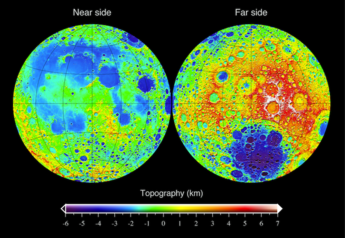
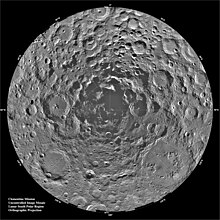


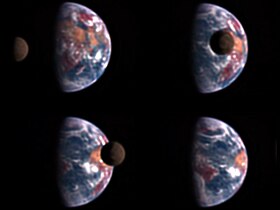
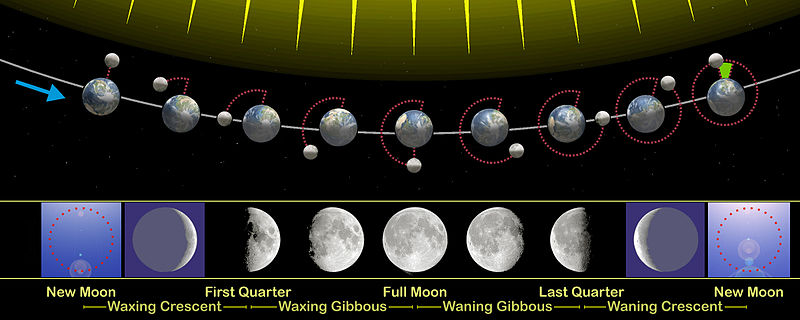


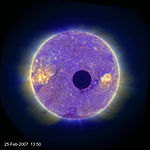
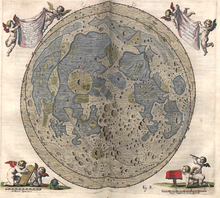


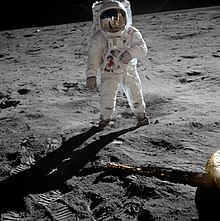
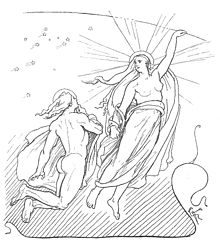


No comments:
Post a Comment